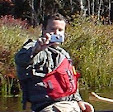 |
| Original RICA (RICKA) Logo |
The Branch River Race, later known as the Rhode Island Whitewater Championship, was established by the Rhode Island Canoe Association (RICA, now RICKA) in 1980. For 25 years it was run on the third weekend in March - the first race of the year on calendar the New England Downriver Championship series (now the New England Canoe and Kayak Racing Association).
This well-known race was run in accordance with American Canoe Association rules. All racers had to submit to safety inspections, and improperly equipped boats or paddlers were not be allowed to participate. All entrants were required to wear PFD’s, spray skirts (for kayaks) and helmets. Wetsuits and drysuits were strongly recommended, as were float bags in canoes and kayaks.
 |
| Original race logo |
The base of operations for the race was the Townsman Club, later the Village Barn and now the Western Hotel. Classes were included for canoe and kayak, with classes for recreational, mixed, women and masters. There was even a “tavern” class competing for the coveted “Saloon Cup”.
The race was run on Rhode Island’s only whitewater river – the Clear and Branch from Harrisville to Nasonville. The 7-mile course began below the Route 107 Bridge and ended above the Slatersville Reservoir. It is mostly quickwater with some flatwater and four class II rapids.
 |
| Running Glendale |
The first rapid was at the start below the Route 107 Bridge. The next rapid was about a half mile downstream at the Whipple Drop - a broken dam with a 2½-foot drop and a canoe-busting boulder about 25 feet downstream.
About 3½ miles downstream was the portage at the Oakland Dam. Below the dam, was a mile-long section of quickwater that led to the Glendale Rapid. This short, rocky rapid caused problems for new and experienced paddlers alike.
 |
| Running Mohegan (Atlas Pallet) |
After another half mile of quickwater was the Mohegan (now called the Atlas Pallet) Rapid. This rocky drop changed at different water levels. It always required superior maneuvering skills but became easier as the water level rose. Another half mile downstream was the portage at the Nasonville Dam. After that, the remainder of the run was quickwater.
As with all RICKA events, safety was a principal concern. Safety checkpoints were set up at critical points along the route. From many years, the Ocean State Amateur Radio group partnered with RICKA to provide real-time communication between safety personnel on the racecourse, and those back at race headquarters.
 |
| 25th Anniversary Poster |
The Branch River Race was an important fundraiser for RICKA, and provided the opportunity for new paddlers to experience whitewater paddling using good safety practices under relatively controlled conditions. The race continued for 25 years, but eventually had to be discontinued due to the high cost of insurance and problems with river access.
Today, many RICKA paddlers still paddle the Clear and Branch on the traditional third weekend in March.
 |
| The Race Map |









No comments:
Post a Comment
Note: Only a member of this blog may post a comment.